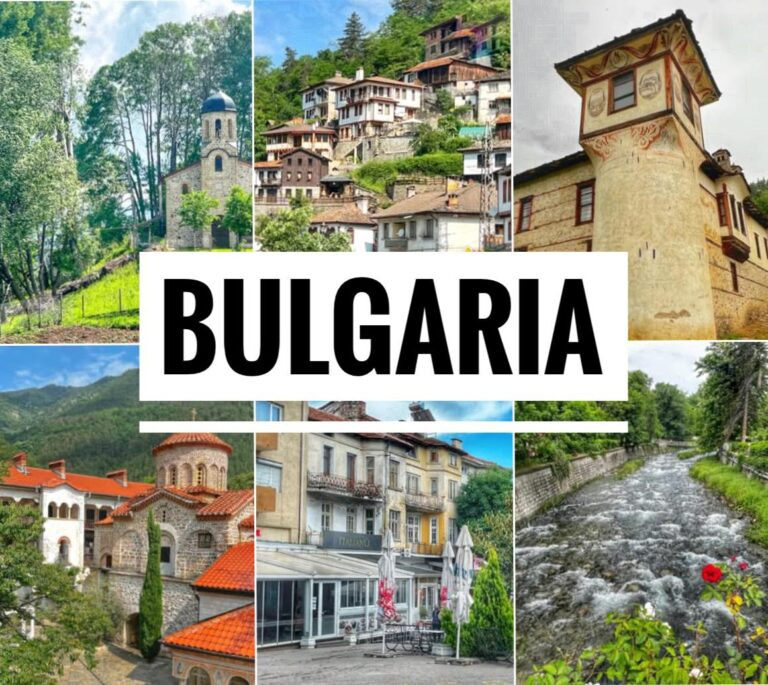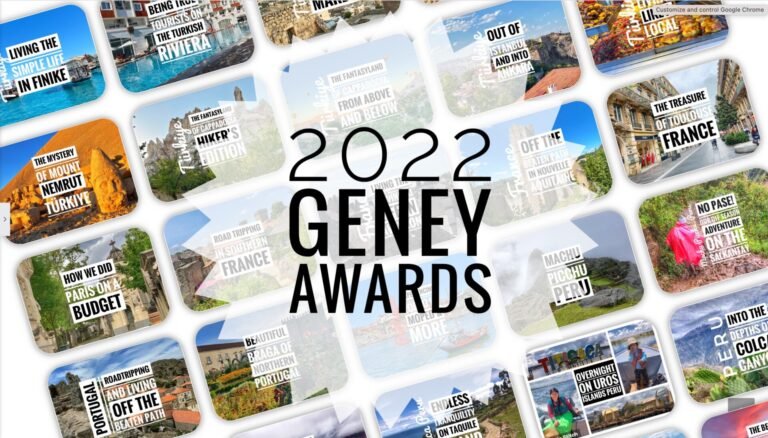
Thailand/Cambodia Poipet Border Crossing
We bust through another border! After all the reading and blog watching we’d done about the Poipet border, we actually thought it was going to be a challenging one so we made sure to get an e-visa online and not do a visa on arrival. By doing this, you can just bypass the touts with their ingenious little scams and it’s a breeze. No issues here!
Of course, little did we know, we would need to extend our visa multiple times and the visa we chose was probably not the easiest option. We could have also chose a business visa on arrival and just set gone ahead and set up a brewery. COVID hindsight is always 2020…pun intended.


The bus ride was 5 hours from Bangkok to the border and two hours from the Cambodian border to Battambang. These pictures are taken in the border town of Poipet.

Our first taste of Khmer food was pretty tasty, although it seems it’s gonna be tough to be a vegetarian here. This dish consisted of pineapple, onion, carrots and minced pork (uh, we think??)

We also got to experience our first sleeper bus from the border to Battambang, which includes reasonably comfy sleeper pods for two people. This is all fine and dandy when you’re with your spouse, but imagine getting socked into one with a complete stranger. Um. No thank you. They do ask you when you buy the ticket if you’re male/female, so hopefully this means they at least put women with women and men with men.

The sleeper pod. Unfortunately we got stuck on the bottom bunk which was far less more roomy in the headspace area. Mandy looks like a (sweaty) deer in headlights. Note: there’s no reading lamps either so make sure to either have a flashlight or e-reader if you don’t plan on sleeping.

Cozy. The ride unfortunately went from two to four hours because the driver went the wrong way one time, and also he kept stopping for…we don’t know what, although one stop included a pick up of a large number of boxes which were annoyingly and very loudly shoved in the bunk next to ours. We think something may have been wrong with the bus causing the stops, so we were destined to lay there. It was okay for Mandy but difficult for Greg who was frantically trying to battle the first major Coronavirus stock market plummet using just our iPhone.

The bus! It had AstroTurf carpet and you had to take off your shoes and put them in a plastic bag (more plastic) when you entered.

Battambang
Our first stop in Cambodia took us to the country’s second biggest city of Battambang (population 200,000.) Based on this, you might expect it to be a hustling and bustling Asian city, but in fact it was so subdued we felt comfortable renting a motorbike and walked freely without a lot of leapfrogging activity. Not to mention, it had French-colonial appeal in its architecture, a lovely river walk, some quirky things to day trip to, and delicious food options. We definitely recommend at least 3 nights here.
Battambang, founded in the 11th Century, developed separately from most of Cambodia and fell under Thai jurisdiction for much of its history. The province was returned to Cambodia in 1907 when the French paraded in to drape the city in colonial and francophone influence. Parts of it even felt a little New Orleans-esque. Oh and P.S., thanks to that influence…the bread is back!! Whoohoo!

Three little Cambodian cuties atop a parked truck on the side of the road. We get how Angelina Jolie decided to scoop a few up.

It’s interesting to see how the vehicles change from Asian country to country. Meet a Cambodian tuk tuk. Aka, a remork…basically a large trailer hitched to a motorcycle which operates as a low-tech local bus used throughout Cambodia to transport people and goods. We even saw one (bigger than this one, thankfully) carrying three cows!!

As in Thailand, the markets are stocked with fruits and veg…plentiful, fresh and dirt cheap.

If you’re more of a processed foods kinda person, you can also opt for Lays. But they must be healthier with a flavor like salted egg? ?

Or, if you’re a carnivore, you can be reminded what your food looks like in great detail.
For the record, most of the markets we visit are “wet markets.” You might have noticed that this term has been in the media a wee bit lately thanks to COVID. Wet market does not mean they sell bats, and turtles and cats and originate only in China (thanks media.)
A wet market in reality is any market than sells perishable food, which can include produce, or meats. They are referred to as “wet” owing to the fact that floors are often hosed down after vendors wash vegetables or clean fish. Dry markets, on the other hand, sell non-perishable goods and are typically swept or vacuumed.

We’re realizing it’s pretty much the norm to stumble across awe-striking pagodas and wats everywhere you wander in Cambodia. This was nothing “special” enough to earn it a place in our guidebook, but we thought the entrance to Sangke Pagoda, said to have been built around 1100 was one of these wonders. It featured a four-faced Angkorian-style image on the gopura above the main entrance to the temple. The four faced image is not the Lord Buddha as you might think, but the Hindu God Brahma who is often depicted in Hindu temples has having four faces to represent the four vedas, which are the ancient holy scriptures of the Hindu religion.

You may have also noticed the stern looking men carrying what appears to be a massive snake, which represents the Naga (serpent) King which surrounds the perimeter of the temple. Nagas, have high status in Hindu mythology, primarily representing rebirth, death and mortality, due to its casting of its skin and being symbolically “reborn.”

Streets of Battambang.

We chose to stay a the “Royal Hotel” which the guidebook proclaimed to be a “traveler” favorite ($13/night). It had A/C, which we’ve realized is all we really care about in 100 degree humid heat. In addition, if offered a rooftop jacuzzi with cool water and a really nice view of the city.

Welcome to Cambodia. Otherwise known as heaven. Where ice cold beers flow out of the tap and are plopped gloriously in front of you for the regular price of $.75. Or perhaps $.50 for happy hour.

When we said ice cold, we meant ice cold. That’s right. In Cambodia it’s common to get not only ice in your beer but also an environment-killing straw.

Or, if wine is more your thing, it’s readily available here. (Thanks Frenchies!) Of course, our budget preferred the former option. A average bottle of wine was still $8-$12.

However, the day we rented the motorbike, we did decide it was a must to do a tasting ($2.50!) at Cambodia’s only winery and vineyard. After all, it had been nearly eight months since we’d had good wine. The entrepreneurs at Prasat Phnom Banan Winery apparently wanted to prove that wine could indeed be made in the tropics. Well, they did pump out something that sort of looked like wine, and it was certainly served in a proper glass. However, the flavor more matched a refined vinegar or, for our Ameri-readers, a bottle of Trader Joe’s Two-bucks-a-Chuck which has been sitting open for two weeks. Ah, well. They tried. They did much better on their ginger and grape juices and even brandy which is what was in the other glasses.

A typical street side eatery in Cambodia.
Another beautiful pagoda on our motorbike tour of the countryside. It’s amazing how every single little village has an immaculate temple.
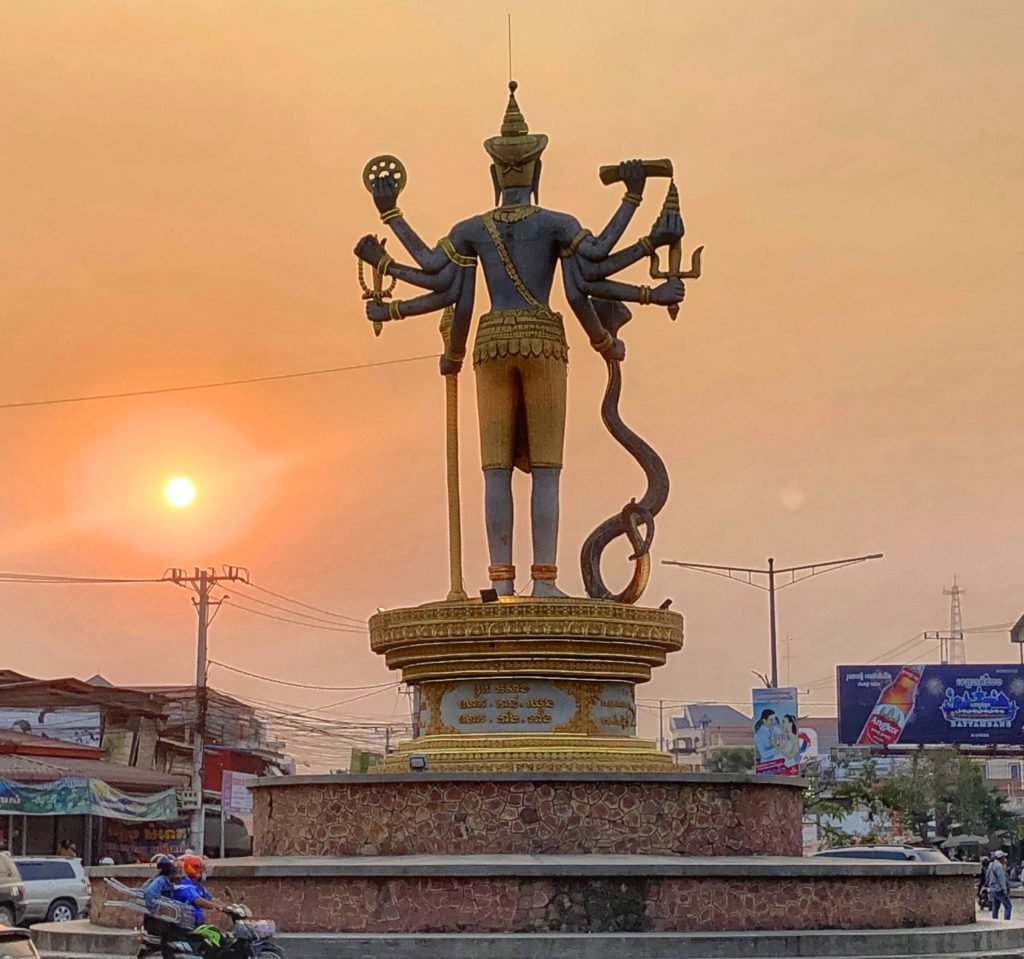
This statue is at both the main entrances to Battambang. We didn’t really figure out the meaning, but it curiously seems to be a Hindu god.

This sweet, piteous lady was sitting on the side of the road near the statue. We wished we could hear her story. Cambodians have been through hell and back in recent history.

The same girls from earlier in a truck’s upper cage. They look like they’re just having a happy social hour and enjoying themselves. Not sure of the parents whereabouts but we’re sure they weren’t far. It’s kind of refreshing to see kids acting like kids here without helicopter parents fluttering about.

Another little one near her mom’s motorbike. Note the plastic cup, inside the plastic bag. Unfortunately this is how all drinks are served here. So. Much. Plastic. ?♀️

At Smokin’ Pot—our favorite street eatery in Battambang, which we went to twice. It was that good.

A couple meals from Smokin’ Pot-fish amok, which is a fish curry served in banana leaf and Cambodia’s National dish, as well as a pineapple fried rice dish. Love how they use pineapple as a staple ingredient here. Yum. Overall, Khmer food is similar to Thai food but with far less spice. The good news is that the spice bowl is always perched on the edge of the table for some fiery additions.

We enjoyed walking, and even running, on Battambang’s river walk which runs parallel to an equally enjoyable street. In the late afternoon, fruit shake, food and dessert stalls set up and you can also find the residents of Battambang using the gym equipment lined down the middle.

The main restaurant bar drag was quite desolate, but incredibly atmospheric.

One of the many prevalent non-profits throughout Cambodia is seeing hands massage services which provides blind persons who may not be able to work otherwise with good paying jobs. We still hope to go to one.
The Battambang Bamboo Railway
This world famous bamboo train in Battambang and is basically a small wooden-framed rickety bamboo deck that sits atop two independent axles, reclaimed from damaged tanks left over from their civil war.

Climbing aboard the Battambang bamboo train you get the opportunity to fly down the rails at 30 mph on nothing but some bamboo slivers, seeing the earth glide by beneath you and watch the Cambodian countryside go by.
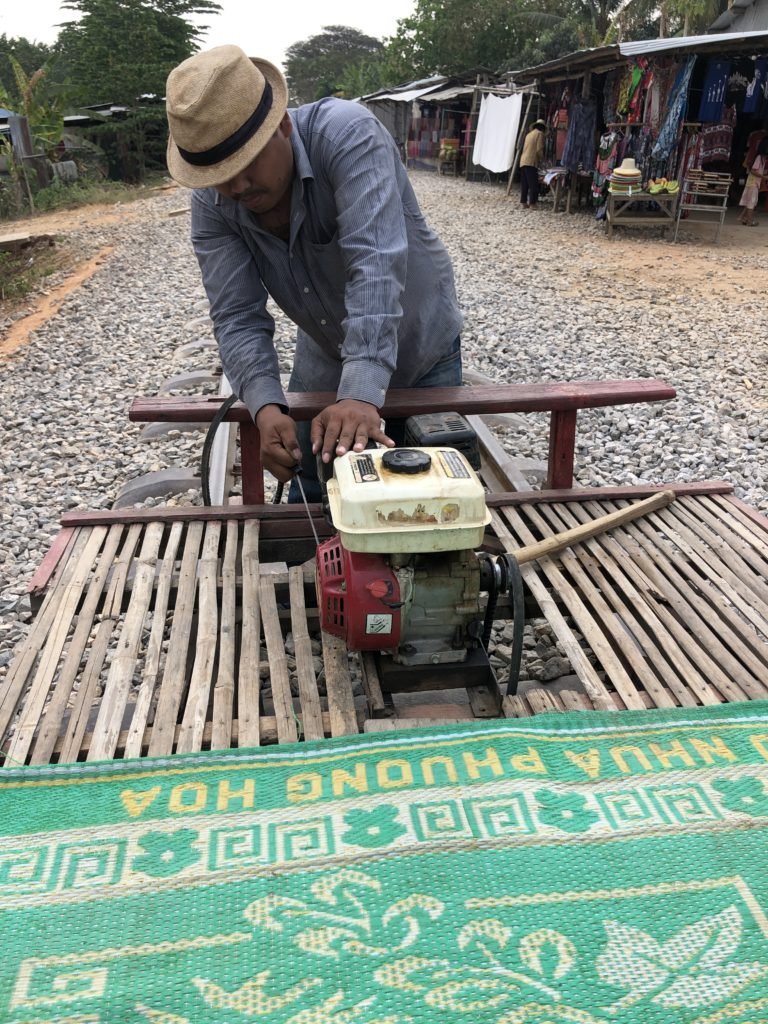
It appears to run on a moped engine, which propels the bamboo train forward through a very simple but ingenious use of a belt around the crank which attached to the rear axle while the engine sat on sliding rails. The driver would push the engine forward on the rails tightening the belt and accelerating the car forward.
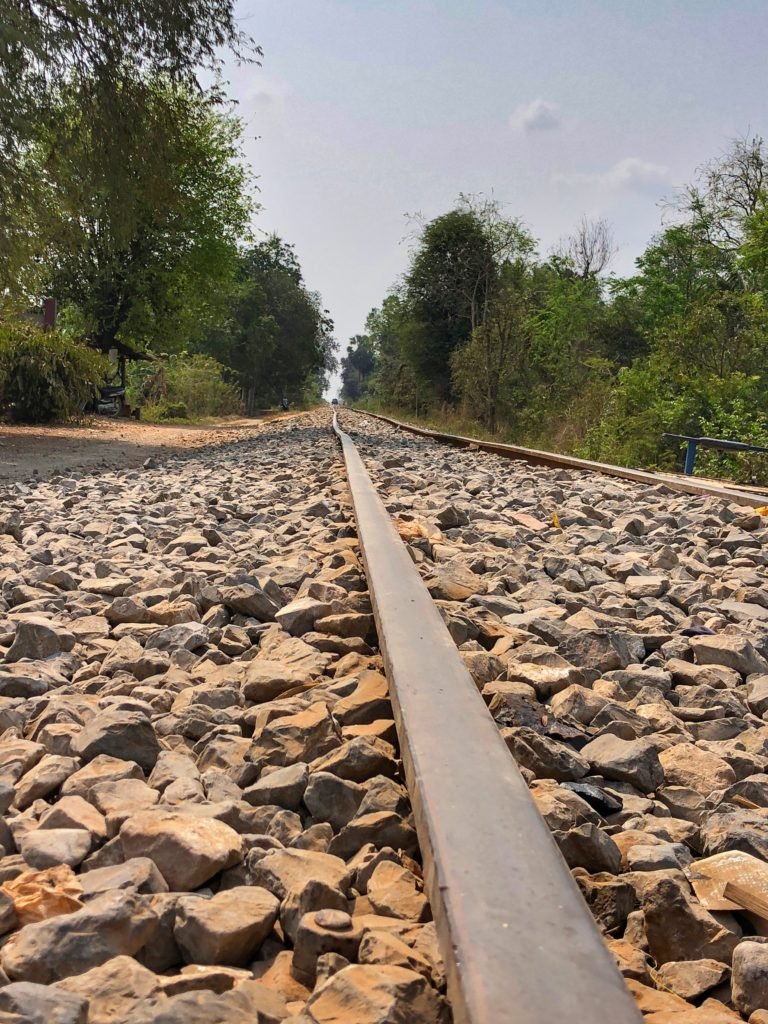
The ingenuity of the locals persevered in a time when the Cambodians had few resources available to transport goods. This improvised rail vehicle was originally conceived as a logistical fix during the UN Transitional Authority of Cambodia period. The original “bamboo train” was a lorry system that operated on Cambodia’s rarely used northern rail line.
Today it’s just good tourist fun at $5/head. We read it was overtouristed but we found the experience to be worthwhile and unique. What a great money maker for them using available resources.

At the end of the line, we reached a tiny village where all cars stop, which of course is full of vendors trying to sell you stuff. We were greeted by an eager, yet hospitable 13-year-old boy who spoke excellent English and his mom, (who didn’t). They invited us into their shop where we had some coconut water and papaya, and Mandy bought a couple of bracelets because he was such a witty salesman. He had aspirations to be a tour guide one day and his favorite subject is math.

We loved hanging out with them.
Phnom Sampov Bat Cave

We got to the Phnom Sampov mountain-top pagoda complex in time to see the bats whipping out of the Bat Cave at dusk but disappointingly without enough time to enter the rest of the complex.
The millions of bats were fascinating to watch as they glided through the sky in ribbon-shaped patterns.

The setting sun is such a sight in Cambodia.
Siem Reap
Siem Reap is Cambodia’s most famous and spectacularly popular tourist hot spot. The town is however is much more widely known for what sits just a few kilometers past the edges of its urban sprawl… a true world wonder. Angkor Wat. By the time we arrived in Siem Reap tourism was already showing signs of slowing due to the Covid-19 outbreak. In all we spent 7 nights, exploring both enigmatic Angkor Wat and the fun markets, massages, fish spas and bountiful bars/restaurants of Siem Reap. Because of intense competition Siem Reap has become a place of contrasting values… unbelievably cheap yet luxurious accommodation ($18/night in our case). For that price we got a huge buffet breakfast , rooftop pool, in a boutique hotel with stunning architecture and a splurge on a budget. Among the many culinary distractions you’ll find in Siem Reap will be, ummmm, an upscale… insect tapas bar. (The buggy edibles are pictured last, for those who might get queasy tummies.)

The exquisite lobby where we stayed at Hello Cambodia Boutique. This was the most luxury hotel experience we’ve had since the Maldives which we couldn’t believe we got for just $18/night.

The inviting rooftop pool.

Our room. Naturally we got the most budget-friendly option in this swanky place, but it still included a very fancy (and complicated) shower, a mini bar (which we stuffed full of our own food of course), a safe, and of course…bathrobes. The bed was expectedly also very comfy!

The breakfast buffet included tropical fruits, croissants (thanks to the French influence), and the most delightful coffee we’ve had in a long time. It also included a choice of 12 additional ala carte menu options. We loved the Eggs Benedict.

Happy hour drinks were two for one(!) so we got two cocktails for $4 one day!

The spa menu. We cannot believe, but somehow, resisted it. Especially a 2.5 hour package including a facial, massage and foot reflexology for $34. Actually quite expensive for Cambodia where an average 60 minute massage goes for about $5-$10.

We fell in love with the brilliant DIY centric-BBQ restaurants in Siem Reap. Funnily, the set up includes these kindergartner-sized plastic tables and chairs. A small iron pot which becomes your grill is placed on your table, then some charcoal is tossed in and boom, you’re in business. You can order any meats or fresh veggies you want, and then it’s up to you to grill it yourself. Cooked, or overcooked, as you want it. This night, we got three plates of veggies, one plate of chicken, and a pitcher of beer. The final cost was $6.50. $5 for the food and $1.50 for the beer.

Our masterpiece!
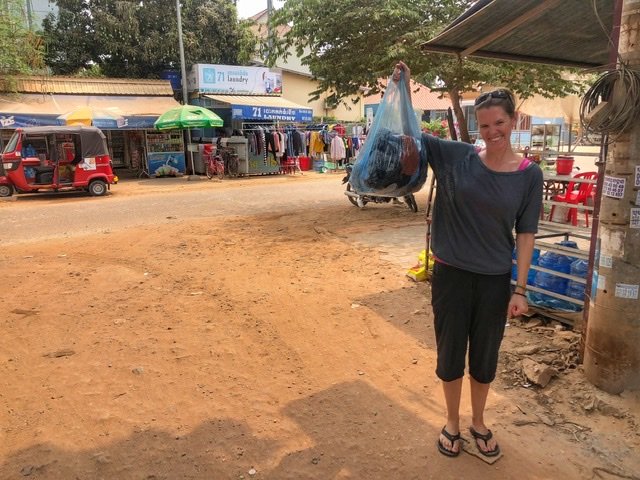
We stopped in our tracks and did a double-take at this sign advertising 7 kilos of laundry for $1!!! We humbly handed over our 4 kilos when actually we could have got three more for the same price, but… that was all our clothes!

“Pub Street” in Siem Reap is usually a complete zoo of tourists. But for us, it was quite pleasant.

Happy hour time!

Look closely at the receipt for how much we spent! Then look at the quantity for that price! Speaking of which, yep, those prices are in USD. Cambodia uses US dollars. It’s been odd to have full access to it (yes, it shoots right out of ATMs) while we’ve been in Cambodia. In addition to the dollar, they also use Riels, which is basically used as change because they don’t have our coins. It felt a bit strange at first to be using the ol’ greenbacks again, but we’re adjusting. At least we don’t have to pay any conversation fees!

Pub Street at night.

We were a little hesitant if we wanted to participate in the incredibly gimmicky and sometimes ethically dubious, fish spa experience. We’d avoided it in the past because it had been stupidly overpriced, and some operators practice animal cruelty by starving the fish to make them hungry. But when we were offered $3 for an unlimited time, we thought…let’s try it. We could give the fish a nice big meal, and were very curious what it would feel like.

For those that aren’t familiar….fish spas involve putting your feet into a fish tank filled with Garra rufa fish — also called “doctor fish” — which are a freshwater fish that originally come from Central Eurasian river basins. The fish nibble the dead skin off of your feet and legs, as well as helping to stimulate blood flow and circulation. It was straight up…bizarre. It’s difficult to describe how much it tickled. Almost as though there were tiny currents of electricity going throughout your feet.
Mandy’s initial first reactions! We tried to feed our fish for at least 20 minutes, making sure we helped fill their little bellies as much as we could. But we may also have contributed to a practice that probably shouldn’t be going on in the first place. ?

One thing we had to try in Cambodia was a Banana Flower Salad. It combines shredded banana flower, mango, onion, carrots, coriander, mint and peanuts drizzled with a lime, garlic and soy sauce-based sauce. We a happy to report it is absolutely divine!!!

Nuts and snacks in little plastic cups. It looked like a Whole Foods selection, with a $1-$1.50 Cambodian price tag!

A monk walking down the street. Even they are wearing masks these days!
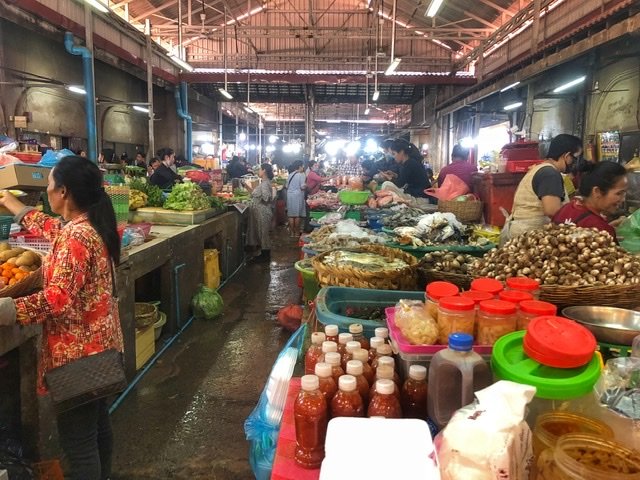
One of the central markets in Siem Reap.

The shopping was stellar. In an effort to restock some worn out clothes, Mandy spent $4 on a pair of pants and t-shirt.

One of the lovely green spaces near the river.
Bugs Cafe

A question a lot of travelers get is, what’s the craziest thing you’ve ever eaten?! Well, until recently, our answer was big-bottom ants in Colombia and some crickets in Bangkok, which didn’t feel very…crazy. Then, we stumbled upon Bugs Cafe, an insect tapas bar (not even kidding)!! Mandy at first had a bit of an inward battle with herself, but her need for adventure ultimately overruled her vegetarian tendencies. Besides….uh…it’s “just” bugs, right? ?

Some of the menu choices. As you can see, bugs weren’t cheap at this upscale joint. We decided to splurge on what is considered a delicacy in Cambodia… an entire sampler platter for $15.


It included an insect skewer of grasshoppers, a scorpion, a water bug and some veggies for good measure.

Some fire ant spring rolls, which were very tame and easy to eat, especially thanks to the accompanying sweet chili sauce.

What’s inside that spring roll…


A cricket & silkworms wok, which was also combined with vegetables and a dash of spiciness. The green round things are actually pods of black pepper.

Inside a tarantula donut. The worst part of eating this was the psychology of it. All in all, it wasn’t awful although the scorpion definitely was, resembling plastic. Insect eating has been around for awhile in many parts of the world, but the fact is that eating spiders only became widespread in the 1970s amid starvation brought on by the Khmer Rouge regime.

The giant water bug was also incredibly unnerving, because, well, it resembles a cockroach. Ugh!! But we closed our eyes and went for it and, It was not good. It did have a strange sweetness to it. And it was the crunchiest thing we’ve ever eaten for sure!!! If you’re brave enough, we certainly invite you to watch the whole video!
All in all, this was a very entertaining and interesting experience that we’re glad to have tried. We will likely never repeat this experience… once was enough. However, we’d say we’re happy to have gotten out of our comfort zone and experienced bug tapas.
Of course, if COVID gets really wiped out our food supply at least we won’t starve with the knowledge that it can be done….

